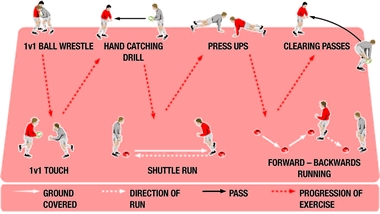
Rugby Training Drills: A Comprehensive Guide for Players of All Levels
Rugby, a physically demanding and strategically complex sport, requires rigorous training to hone players’ skills, fitness, and tactical understanding. Effective training incorporates a variety of drills designed to improve specific aspects of the game, from individual technique to team cohesion. This comprehensive guide outlines key rugby training drills for players of all levels, focusing on different aspects of the game and offering variations to cater to individual needs and team goals.
I. Skill-Based Drills:
These drills focus on perfecting individual skills crucial to rugby performance. Consistent practice is vital for developing muscle memory and instinctive reaction.
-
Passing Drills: Accurate and efficient passing is fundamental. Drills include:
- Two-Man Passing: Players stand a few meters apart, passing the ball back and forth, focusing on speed, accuracy, and a tight spiral. Variations include incorporating different types of passes (inside, outside, pop pass) and changing the distance.
- Three-Man Passing: Introduces a third player, creating a triangle passing pattern. This enhances decision-making and communication.
- Passing Under Pressure: A defender is added to pressure the passer, forcing quick thinking and accurate passing under duress.
- Zig-Zag Passing: Players run in a zig-zag pattern, passing the ball to each other. This improves passing while moving and coordination.
-
Catching Drills: Secure catching is essential to prevent turnovers. Drills include:
- One-Handed Catches: Improves dexterity and control, crucial for catching in congested areas.
- High Balls: Practicing catching high kicks and aerial passes develops anticipation and jumping technique.
- Catching Under Pressure: Similar to passing drills, this incorporates a defender to simulate game pressure.
-
Tackling Drills: Effective tackling is paramount for defense. Drills include:
- Tackling Bags: Players practice tackling technique on tackling bags, focusing on proper body position, shoulder alignment, and follow-through.
- Tackling Pads: Similar to bags, pads allow for partner drills, focusing on timing, technique, and wrap-up.
- Live Tackling: Controlled tackling drills with teammates focusing on safe tackling technique and minimizing injury risk. Emphasize proper technique and controlled hits.
- Tackling Drills with evasion: Combining tackling and evasion to enhance both defensive and offensive skills. Players practice both tackling and avoiding tackles simultaneously.
-
Kicking Drills: Kicking is crucial for territorial gains and scoring points. Drills include:
- Place Kicking: Practice place kicking from different distances and angles, focusing on accuracy and consistency.
- Conversion Kicking: Practice kicking conversions after a try, focusing on accuracy under pressure.
- Drop Goal Kicking: Practice drop goal kicking, focusing on timing and technique.
- Kick-offs: Practice kick-offs, aiming for touch and distance.
-
Rucking and Maul Drills: Effective rucking and mauling are crucial for securing possession. Drills include:
- Rucking Technique Drills: Focus on binding, support, and driving, with a strong emphasis on safety.
- Maul Drills: Practice maul formations, lifts, and drives, working on both attacking and defending mauls.
- Ruck and Maul under pressure: Introduce opponents to practice securing the ball and defending the ruck/maul in a competitive environment.
II. Fitness-Based Drills:
Rugby demands exceptional fitness. Drills should target speed, strength, agility, and endurance.
-
Interval Training: High-intensity interval training (HIIT) improves both aerobic and anaerobic fitness. Examples include sprints interspersed with rest periods, repeated shuttle runs, and hill sprints.
-
Strength and Conditioning: Weight training and bodyweight exercises build strength and power. Focus on compound exercises like squats, deadlifts, and bench presses, along with plyometrics for explosive power.
-
Agility Drills: Cone drills, ladder drills, and shuttle runs improve agility and footwork, essential for evading tackles and creating space.
-
Endurance Drills: Long-distance runs, continuous running drills, and fitness tests build stamina and endurance, crucial for playing a full match at a high intensity.
-
Plyometrics: Plyometric exercises, such as box jumps and depth jumps, enhance explosive power and agility.
III. Team-Based Drills:
These drills focus on developing team cohesion, communication, and strategic understanding.
-
Lineout Drills: Practice lineout throws, jumps, and catching, focusing on timing, accuracy, and communication between the thrower and jumpers. Variations include practicing different lineout moves and defending the lineout.
-
Scrum Drills: Practice scrum engagement, pushing, and winning ball, focusing on technique, strength, and communication. Variations include practicing different scrum moves and defending the scrum.
-
Set-Piece Drills: Practice attacking and defending set pieces such as scrums, lineouts, and rucks, focusing on coordination and communication.
-
Breakdown Drills: Practice attacking and defending breakdowns, focusing on speed, accuracy, and winning the ball. This drill can be combined with rucking drills for a more comprehensive approach.
-
Game-Specific Drills: Simulate game scenarios, focusing on specific plays and strategies. These drills can be tailored to the team’s strengths and weaknesses. Examples include attacking drills focusing on phases of play, and defensive drills focusing on covering space and tackling effectively.
IV. Variations and Considerations:
The drills described above can be adapted to suit different player positions, skill levels, and team objectives. Coaches should consider:
-
Player Fitness Level: Adjust the intensity and duration of drills based on players’ fitness levels.
-
Skill Level: Begin with simpler drills and gradually increase complexity as players improve.
-
Position-Specific Drills: Tailor drills to the specific demands of each position (e.g., scrum-half passing drills, flanker tackling drills, fullback kicking drills).
-
Team Strategy: Align drills with the team’s game plan and strategic objectives.
-
Safety: Prioritize safety throughout all drills. Ensure proper warm-up and cool-down routines, and emphasize correct techniques to minimize injury risk.
-
Fun: Incorporate elements of fun and competition to maintain player motivation and engagement.
Regular, well-structured training, incorporating these diverse drills, is vital for success in rugby. By focusing on individual skills, fitness, and team play, players can improve their performance, build confidence, and contribute to their team’s success. Remember that consistent effort, combined with a strategic approach to training, will yield significant results. Regular review and adaptation of training plans are crucial to ensuring continued progress and addressing specific team needs.



